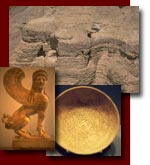| Site Map | Contacts | Links | Newsletter | |
Biblical Archaeology:
Cuneiform
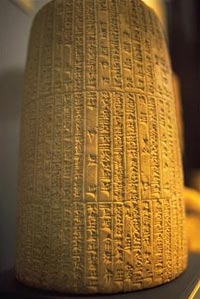 |
The next greatest discovery was cuneiform tablets, and their decipherment. |
Cuneiform means "wedged shaped" in Latin. This refers to ancient writings that had a wedged shaped appearance. The writing is usually made with a wedge stylus on soft clay tablets. Baking the tablets preserves them. A number of different ancient languages are written in cuneiform. The most widely used language was Akkadian. Cuneiform is also chiseled on to stones and rocks. One famous carving on a cliff three hundred feet up is the Rock of Behistun in ancient Persia, now modern day Iran southwest of Tehran.
The man most responsible for the decipherment of cuneiform is Henry Rawlinson. Henry started to work for the East India Company in 1827 at the age of seventeen where he learned Indian languages and Persian. In 1835 he was sent to Persia as a military adviser. Near the city of Kermanshah he found two inscriptions on rocks which he figured out the names of Darius and Xerxes. He then started to copy the inscriptions on the Rock of Behistun some three hundred feet up on very shaky wooden ladders. In 1849 he completed his book Memoir on the Persian Version of the Behistun Inscriptions.
There were two other unknown ancient languages on the Rock of Behistun that said the same thing in Old Persian so Rawlinson turn his attention to their decipherment. In 1855 he published a book with notes and translation of the second language named Elamite.
Finally Rawlinson turned to the last language Babylonian cuneiform, or today called Akkadian. Edward Hincks, a Anglican clergyman had devoted himself to the decipherment of Akkadian. By 1847 he published a list of their signs and meanings. With the writings of Rawlinson and Hincks the Akkadian language was deciphered. Hincks was right in observing the signs stand for syllables. The final test came in 1857 when four scholars, Rawlinson, Hincks, Henry Talbot, and Jules Oppert independently translated the same script and came up with virtually the same translation.
Discoveries of Cuneiform Archives (Akkadian)
Discovery of Ashurbanipal's library of 22,000 tablets.
Sir Henry Layard in the 1850's dug these tablets up from the runs of Nineveh, and brought them back to the British Museum in London.
Discovery of the Mari tablets.
These tablets help illustrate the Patriarchal period dealing with customs, language, and personal names.
Discovery of the Nuzi tablets.
These tablets help illustrate the Patriarchal period dealing with legal customs like adoption and birthright sales.
Key Tablets Relating to the Old Testament
The Babylonian Flood Story
In 1872 George Smith was cataloging the fragments of tablets from Ashurbanipal's library when he discovered a story very similar to the story of Noah's flood. This created a sensation. He raised money to return to Nineveh to find the rest of the tablets which he amazingly did. The flood story belonged to the eleventh, and last tablet of a much longer story called the Gilgamesh Epic.
The Atrahasis Epic
This Epic describes creation and early human history including the great flood. Parallels Genesis 1-9.
Enuma Elish
A seven tablet story of the creation of the world by Marduk the supreme god of the Babylonian pantheon.
Hammurapi's Code
This code or laws are from the 18th century BC. They are very similar to the laws of Moses. There are some differences as well. One could buy his way out of some punishments under Hammurapi's Code. Below is a picture of Hammurapi receiving the blessing of the Sun god Shamash.
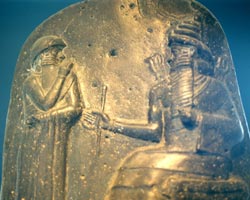
Ishtar's Descent (into the Underworld).
There is a similar description of Sheol in the Old Testament. This helps us in our understanding of what the ancient world thought the netherworld was like.
Tablets that parallel the book of Job; Ludlul Bel Nemeqi, and Babylonian Theodicy.
Shalmaneser's Black Obelisk (9th century BC).
In the picture below King Jehu of Israel is pictured bowing to Shalmaneser III, and Israel is bringing tribute to him. This gives the first clear picture of what the Israelites looked like.
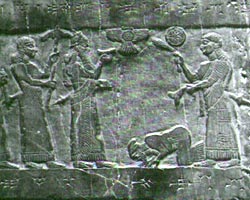
Sargon's Legend, and Sargon's Inscription.
Sargon I's legend is similar to the birth of Moses story in Exodus 2. Sargon II's inscription claims the conquest of Samaria 722 BC and the capture and exile of 27,290 Israelites.
Shennacherib's Prism (7th century BC).
Shennacherib describes the seige of Jerusalem in 701 BC. Hezekiah is like a bird in a cage (see 2 Kings 19:35-37). Below is the display of Shennacherib's Prism on the left (also called the "Talyor Prism") in the Oriental Institute Museum at the University of Chicago.
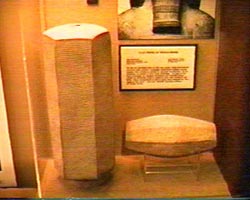
Nabonidus Chronicle (6th century).
Describes his absence and his son Belshazzar's rule in Babylon.
Nechadnezzar Chronicle (6th century).
Describes the siege of Jerusalem in 597 BC (2 Kings 24:10-17).
Jehoichin's Ration Dockets (6th century).
Short texts on rations to the exiled king Jehoichin of Judah.
Pessimistic Dialogue.
Similar to the first two chapters of the book of Ecclesiastes.
Murashu Tablets (5th century BC).
Describes business done with Jews and other exiles.
Cyrus Cylinder.
Describes the fall of Babylon and the return of the Jews to Jerusalem.
